Chapter 13: Physical Development in Early Childhood
Chapter 13 Learning Objectives
- Summarize the overall physical growth
- Describe the changes in brain maturation
- Describe the changes in sleep
- Summarize the changes in gross and motor skills
- Describe when a child is ready for toilet training
- Describe sexual development
- Identify nutritional concerns
Overall Physical Growth
Children between the ages of two and six years tend to grow about 3 inches in height and gain about 4 to 5 pounds in weight each year. Just as in infancy, growth occurs in spurts rather than continually. According to the Centers for Disease Control and Prevention (2000), the average 2-year-old weighs between 23 and 28 pounds and stands between 33 and 35 inches tall. The average 6-year-old weighs between 40 and 50 pounds and is about 44 to 47 inches in height. The 3-year-old is still very similar to a toddler with a large head, large stomach, short arms, and legs. By the time the child reaches age 6, however, the torso has lengthened, and body proportions have become more like those of adults.
This growth rate is slower than that of infancy and is accompanied by a reduced appetite between the ages of 2 and 6. This change can sometimes be surprising to parents and lead to the development of poor eating habits. However, children between the ages of 2 and 3 need 1,000 to 1,400 calories, while children between the ages of 4 and 8 need 1,200 to 2,000 calories (Mayo Clinic, 2016a).
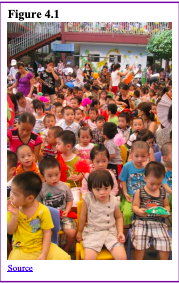
Brain Maturation
Brain weight: The brain is about 75 percent of its adult weight by three years of age. By age 6, it is at 95 percent of its adult weight (Lenroot & Giedd, 2006). Myelination and the development of dendrites continue to occur in the cortex and as it does, we see a corresponding change in what the child is capable of doing. Greater development in the prefrontal cortex, the area of the brain behind the forehead that helps us to think, strategize, and control attention and emotion, makes it increasingly possible to inhibit emotional outbursts and understand how to play games.
Understanding the game, thinking ahead, and coordinating movement improves with practice and myelination.
Growth in the Hemispheres and Corpus Callosum: Between ages 3 and 6, the left hemisphere of the brain grows dramatically. This side of the brain or hemisphere is typically involved in language skills. The right hemisphere continues to grow throughout early childhood and is involved in tasks that require spatial skills, such as recognizing shapes and patterns. The corpus callosum, a dense band of fibers that connects the two hemispheres of the brain, contains approximately 200 million nerve fibers that connect the hemispheres (Kolb & Whishaw, 2011). The corpus callosum is illustrated in Figure 4.2.
Figure 4.2
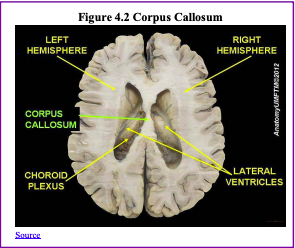
The corpus callosum is located a couple of inches below the longitudinal fissure, which runs the length of the brain and separates the two cerebral hemispheres (Garrett, 2015). Because the two hemispheres carry out different functions, they communicate with each other and integrate their activities through the corpus callosum. Additionally, because incoming information is directed toward one hemisphere, such as visual information from the left eye being directed to the right hemisphere, the corpus callosum shares this information with the other hemisphere.
The corpus callosum undergoes a growth spurt between ages 3 and 6, and this results in improved coordination between right and left hemisphere tasks. For example, in comparison to other individuals, children younger than 6 demonstrate difficulty coordinating an Etch A Sketch toy because their corpus callosum is not developed enough to integrate the movements of both hands (Kalat, 2016).
Motor Skill Development
Early childhood is the time period when most children acquire the basic skills for locomotion, such as running, jumping, and skipping, and object control skills, such as throwing, catching, and kicking (Clark, 1994). Children continue to improve their gross motor skills as they run and jump. Fine motor skills are also being refined in activities, such as pouring water into a container, drawing, coloring, and buttoning coats and using scissors. The table 1 highlights some of the changes in motor skills during early childhood between 2 and 5 years of age. The development of greater coordination of muscle groups and finer precision can be seen during this time period. Thus, average 2-year-olds may be able to run with slightly better coordination than they managed as a toddler, yet they would have difficulty peddling a tricycle, something the typical 3-year-old can do. We see similar changes in fine motor skills with 4-year-olds who no longer struggle to put on their clothes, something they may have had problems with two years earlier. Motor skills continue to develop into middle childhood, but for those in early childhood, a play that deliberately involves these skills is emphasized.
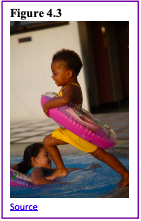
Children’s Art: Children’s art highlights many developmental changes. Kellogg (1969) noted that children’s drawings underwent several transformations. Starting with about 20 different types of scribbles at age 2, children move on to experimenting with the placement of scribbles on the page. By age 3 they are using the basic structure of scribbles to create shapes and are beginning to combine these shapes to create more complex images. By 4 or 5 children are creating images that are more recognizable representations of the world. These changes are a function of improvement in motor skills, perceptual development, and cognitive understanding of the world (Cote & Golbeck, 2007).
The drawing of tadpoles (see Figure: 4.4) is a pervasive feature of young children’s drawings of self and others. Tadpoles emerge in children’s drawing at about the age of 3 and have been observed in the drawings of young children around the world (Gernhardt, Rubeling & Keller, 2015), but there are cultural variations in the size, number of facial features, and emotional expressions displayed.
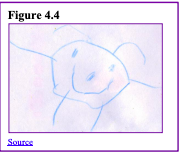
Gernhardt et al. found that children from Western contexts (i.e., urban areas of Germany and Sweden) and urban educated non-Western contexts (i.e., urban areas of Turkey, Costa Rica and Estonia) drew larger images, with more facial detail and more positive emotional expressions, while those from non-Western rural contexts (i.e., rural areas of Cameroon and India) depicted themselves as smaller, with less facial details and a more neutral emotional expression. The authors suggest that cultural norms of non-Western traditionally rural cultures, which emphasize the social group rather than the individual, maybe one of the factors for the smaller size of the figures compared to the larger figures from children in the Western cultures which emphasize the individual.
Table 4.1

Toilet Training
Toilet training typically occurs during the first two years of early childhood (24-36 months). Some children show interest by age 2, but others may not be ready until months later. The average age for girls to be toilet trained is 29 months and for boys, it is 31 months, and 98% of children are trained by 36 months (Boyse & Fitzgerald, 2010). The child’s age is not as important as his/her physical and emotional readiness. If it started too early, it might take longer to train a child. If a child resists being trained or is not successful after a few weeks, it is best to take a break and try again later. Most children master daytime bladder control first, typically within two to three months of consistent toilet training. However, nap and nighttime training might take months or even years.

According to the Mayo Clinic (2016b), the following questions can help parents determine if a child is ready for toilet training:
- Does your child seem interested in the potty chair or toilet, or in wearing underwear?
- Can your child understand and follow basic directions?
- Does your child complain about wet or dirty diapers?
- Does your child tell you through words, facial expressions or posture when he or she needs to go?
- Does your child stay dry for periods of two hours or longer during the day?
- Can your child pull down his or her pants and pull them up again?
- Can your child sit on and rise from a potty chair? (p. 1)
Some children experience elimination disorders that may require intervention by the child’s pediatrician or a trained mental health practitioner. Elimination disorders include enuresis, or the repeated voiding of urine into bed or clothes (involuntary or intentional) and encopresis, the repeated passage of feces into inappropriate places (involuntary or intentional) (American Psychiatric Association, 2013). The prevalence of enuresis is 5%-10% for 5-year-olds, 3%-5% for 10-year-olds and approximately 1% for those 15 years of age or older. Around 1% of 5-year- olds have encopresis, and it is more common in males than females.
Sleep
During early childhood, there is a wide variation in the number of hours of sleep recommended per day. For example, two-year-olds may still need 15-16 hours per day, while a six-year-old may only need 7-8 hours. The National Sleep Foundation’s 2015 recommendations based on age are listed in Figure 4.6.
Figure 4.6
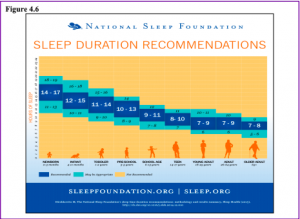
Sexual Development in Early Childhood
Historically, children have been thought of as innocent or incapable of sexual arousal (Aries, 1962). Yet, the physical dimension of sexual arousal is present from birth. However, to associate the elements of seduction, power, love, or lust that is part of the adult meanings of sexuality would be inappropriate. Sexuality begins in childhood as a response to physical states and sensation and cannot be interpreted as similar to that of adults in any way (Carroll, 2007).
Infancy: Boys and girls are capable of erections and vaginal lubrication even before birth (Martinson, 1981). Arousal can signal overall physical contentment and stimulation that accompanies feeding or warmth. Infants begin to explore their bodies and touch their genitals as soon as they have sufficient motor skills. This stimulation is for comfort or to relieve tension rather than to reach orgasm (Carroll, 2007).
Early Childhood: Self-stimulation is common in early childhood for both boys and girls. Curiosity about the body and about others’ bodies is a natural part of early childhood as well. As children grow, they are more likely to show their genitals to siblings or peers, and to take off their clothes and touch each other (Okami, Olmstead, & Abramson, 1997). Masturbation is common for both boys and girls. Boys are often shown by other boys how to masturbate, but girls tend to find out accidentally. Additionally, boys masturbate more often and touch themselves more openly than do girls (Schwartz, 1999).
Hopefully, parents respond to this without an undue alarm and without making the child feel guilty about their bodies. Instead, messages about what is going on and the appropriate time and place for such activities help the child learn what is appropriate.
Nutritional Concerns
In addition to those in early childhood have a smaller appetite, their parents may notice a general reticence to try new foods, or a preference for certain foods often served or eaten in a particular way. Some of these changes can be traced back to the “just right” (or just-so) phenomenon that is common in early childhood. Many young children desire consistency and may be upset if there are even slight changes to their daily routines. They may like to line up their toys or other objects or place them in symmetric patterns. They may arrange the objects until they feel “just right”. Many young children have a set bedtime ritual and a strong preference for certain clothes, toys or games. All these tendencies tend to wane as children approach middle childhood, and the familiarity of such ritualistic behaviors seem to bring a sense of security and a general reduction in childhood fears and anxiety (Evans, Gray, & Leckman, 1999; Evans & Leckman, 2015).
Malnutrition due to insufficient food is not common in developed nations, like the United States, yet many children lack a balanced diet. Added sugars and solid fats contribute to 40% of daily calories for children and teens in the US. Approximately half of these empty calories come from six sources: soda, fruit drinks, dairy desserts, grain desserts, pizza, and whole milk (CDC, 2015). Caregivers need to keep in mind that they are setting up taste preferences at this age. Young children who grow accustomed to a high fat, very sweet and salty flavors may have trouble eating foods that have subtler flavors, such as fruits and vegetables. Consider the following advice (See Box 4.1) about establishing eating patterns for years to come (Rice, 1997). Notice that keeping mealtime pleasant, providing sound nutrition and not engaging in power struggles over food are the main goals:

Tips for Establishing Healthy Eating Patterns
- Recognize that appetite varies. Children may eat well at one meal and have no appetite at another. Rather than seeing this as a problem, it may help to realize that appetites do vary. Continue to provide good nutrition, but do not worry excessively if the child does not eat at a particular meal.
- Keep it pleasant. This tip is designed to help caregivers create a positive atmosphere during mealtime. Mealtimes should not be the time for arguments or expressing tensions. You do not want the child to have painful memories of mealtimes together or have nervous stomachs and problems eating and digesting food due to stress.
- No short-order chefs. While it is fine to prepare foods that children enjoy, preparing a different meal for each child or family member sets up an unrealistic expectation from others. Children probably do best when they are hungry, and a meal is ready. Limiting snacks rather than allowing children to “graze” can help create an appetite for what is being served.
- Limit choices. If you give your young child choices, make sure that you give them one or two specific choices rather than asking “What would you like for lunch?” If given an open choice, children may change their minds or ask for something that is not available or appropriate.
- Serve balanced meals. This tip encourages caregivers to serve balanced meals. A box of macaroni and cheese is not a balanced meal. Meals prepared at home tend to have better nutritional value than fast food or frozen dinners. Prepared foods tend to be higher in fat and sugar content, as these ingredients enhance taste and profit margin because fresh food is often costlier and less profitable. However, preparing fresh food at home is not costly. It does, however, require more activity. Preparing meals and including the children in kitchen chores can provide a fun and memorable experience.
- Do not bribe. Bribing a child to eat vegetables by promising desert is not a good idea. The child will likely find a way to get the desert without eating the vegetables (by whining or fidgeting, perhaps, until the caregiver gives in). In addition, bribery teaches the child that some foods are better than others. Children tend to naturally enjoy a variety of foods until they are taught that some are considered less desirable than others. Most important is not to force your child to eat or fight overeating food.
References
Abuhatoum, S., & Howe, N. (2013). Power in sibling conflict during early and middle childhood. Social Development, 22, 738- 754.
Al-Haddad, B., Jacobsson, B., Chabra, S., Modzelewska, D., Olson, E……. Sengpiel, V. (2019). Long-term risk of neuropsychiatric disease after exposure to infection in utero. JAMA Psychiatry, 76(6), 594-602.
American Academy of Pediatrics. (2015). Gender identity development in children. Retrieved from https://www.healthychildren.org/English/ages-stages/ gradeschool/Pages/Gender-Identity-and-Gender-Confusion-In- Children.aspx
American Academy of Pediatrics. (2016). Media and young minds. Retrieved from https://pediatrics.aappublications.org/content/138/5/e20162591
American Psychiatric Association. (2013). Diagnostic and statistical manual of mental disorders, 5th edition (DSM-5). Washington, DC: Author.
American Psychological Association. (2019). Immigration. Retrieved from https://www.apa.org/advocacy/immigration
Ariès, P. (1962). Centuries of childhood: A social history of family life. New York: Knopf.
Armor, D. J. (2015). Head Start or false start. USA Today Magazine. Retrieved from https://www.questia.com/magazine/1G1-429736352/head-start-or-false-start
Autism Genome Project Consortium. (2007). Mapping autism risk loci using genetic linkage and chromosomal rearrangements. Nature Genetics, 39, 319–328.
Baio, J., Wiggins, L., Christensen, D., Maenner, M., ……. Dowling, N. (2018). Prevalence of autism spectrum disorder among children aged 8 years-autism and developmental disabilities monitoring network, 11 sites, United States, 2014. MMWR Surveillance Summary, 67(No. SS-6), 1-23. doi: http://dx.doi.org/a0.15585/mmwr.ss6706a1External
Bandura, A. (1997). Self-efficacy: The exercise of control. New York: Freeman.
Barshay, J. (2015). Report: Scant scientific evidence for Head Start programs’ effectiveness. U.S. News and World Report. Retrieved from http://www.usnews.com/news/articles/ 2015/08/03/report-scant-scientific-evidence-for-head-start- programs-effectiveness
Baumrind, D. (1971). Current patterns of parental authority. Developmental Psychology Monograph, 4(1), part 2.
Baumrind, D. (2013). Authoritative parenting revisited: History and current status. In R. E. Larzelere, A. Sheffield, & A. W. Harrist (Eds.). Authoritative parenting: Synthesizing nurturance and discipline for optimal child development (pp. 11- 34). Washington, DC: American Psychological Association.
Bem, S. L. (1981). Gender schema theory: A cognitive account of sex typing. Psychological Review, 88, 354-364. Berk, L. E. (2007). Development through the life span (4th ed.). Boston: Allyn and Bacon.
Berwid, O., Curko-Kera, E. A., Marks, D. J., & Halperin, J. M. (2005). Sustained attention and response inhibition in young children at risk for attention deficit hyperactivity disorder. Journal of Child Psychology and Psychiatry, 46(11), 1219- 1229.
Bialystok, E. (2011). Coordination of executive functions in monolingual and bilingual children. Journal of Experimental Child Psychology, 110, 461–468.
Bialystok, E., Martin, M.M., & Viswanathan, M. (2005). Bilingualism across the lifespan: The rise and fall of inhibitory control. International Journal of Bilingualism, 9, 103–119.
Bibok, M.B., Carpendale, J.I.M., & Muller, U. (2009). Parental scaffolding and the development of executive function. New Directions for Child and Adolescent Development, 123, 17-34.
Bigler, R. S., & Liben, L. S. (2007). Developmental intergroup theory: Exploring and reducing children’s social stereotyping and prejudice. Current Directions in Psychological Science, 16, 162-166.
Birch, S., & Bloom, P. (2003). Children are cursed: An asymmetric bias in mental-state attribution. Psychological Science, 14(3), 283-286.
Blackless, M., Charuvastra, A., Derryck, A., Fausto-Sterling, A., Lauzanne, K., & Lee, E. (2000). How sexually dimorphic are we? Review and synthesis. American Journal of Human Biology, 12, 151-166.
Bonifacci, P., Giombini, L., Beloocchi, S., & Conteno, S. (2011). Speed of processing, anticipation, inhibition and working memory in bilinguals. Developmental Science, 14, 256–269.
Boyse, K. & Fitgerald, K. (2010). Toilet training. University of Michigan Health System. Retrieved from http://www.med.umich.edu/yourchild/topics/toilet.htm
Brody, G. H., Stoneman, Z., & McCoy, J. K. (1994). Forecasting sibling relationships in early adolescence from child temperament and family processes in middle childhood. Child development, 65, 771-784.
Brown, G.L., Mangelsdork, S.C., Agathen, J.M., & Ho, M. (2008). Young children’s psychological selves: Convergence with maternal reports of child personality. Social Development, 17, 161-182.
Bureau of Labor Statistics. (2019). Employment characteristics of families-2018. Retrieved from https://www.bls.gov/news.release/pdf/famee.pdf
Bussey, K., & Bandura, A. (1999). Social cognitive theory of gender development and differentiation. Psychological Review, 106(4), 676-713.
Byrd, R. (2002). Report to the legislature on the principal findings from the epidemiology of autism in California: A comprehensive pilot study. Retrieved from http://www.dds.ca.gov/Autism/MindReport.cfm
Camarota, S. A., & Zeigler, K. (2015). One in five U. S. residents speaks foreign language at home. Retrieved from https://cis.org/sites/default/files/camarota-language-15.pdf
Carroll, J. L. (2007). Sexuality now: Embracing diversity (2nd ed.). Belmont, CA: Thomson.
Centers for Disease Control and Prevention. (2000). 2000 CDC Growth Charts for the United States: Methods and Development. Retrieved from http://www.cdc.gov/nchs/data/series/sr_11/sr11_246.pdf
Centers for Disease Control and Prevention. (2012). Prevalence of autism spectrum disorders, autism and developmental disabilities monitoring network, 14 sites, United States, 2008. Morbidity and Mortality Weekly Report: Surveillance Summaries, 61(3), 1–19. Retrieved from http://www.cdc.gov/mmwr/pdf/ss/ss6103.pdf
Centers for Disease Control and Prevention. (2015). Nutrition and health of young people. Retrieved from http://www.cdc.gov/healthyschools/nutrition/facts.htm
Centers for Disease Control and Prevention. (2019). About adverse childhood experiences. Retrived from https://www.cdc.gov/violenceprevention/childabuseandneglect/acestudy/aboutace.html
Chang, A., Sandhofer, C., & Brown, C. S. (2011). Gender biases in early number exposure to preschool-aged children. Journal of Language and Social Psychology, 30(4), 440-450.
Chiong, C., & Shuler, C. (2010). Learning: Is there an app for that? Investigations of young children’s usage and learning with mobile devices and apps. New York: The Joan Ganz Cooney Center at Sesame Workshop. Retrieved from: https://clalliance.org/wp-content/uploads/files/learningapps_final_110410.pdf
Christakis, D.A. (2009). The effects of infant media usage: What do we know and what should we learn? Acta Paediatrica, 98, 8–16.
Clark, J. (1994). Motor development. In V. S. Ramachandran (Ed.), Encyclopedia of human behavior (pp. 245–255). San Diego: Academic Press.
Colwell, M.J., & Lindsey, E.W. (2003). Teacher-child interactions and preschool children’s perceptions of self and peers. Early Childhood Development & Care, 173, 249-258.
Coté, C. A., & Golbeck, S. (2007). Preschoolers’ feature placement on own and others’ person drawings. International Journal of Early Years Education, 15(3), 231-243.
Courage, M.L., Murphy, A.N., & Goulding, S. (2010). When the television is on: The impact of infant-directed video on 6- and 18-month-olds’ attention during toy play and on parent-infant interaction. Infant Behavior and Development, 33, 176- 188.
Crain, W. (2005). Theories of development concepts and applications (5th ed.). New Jersey: Pearson.
De Houwer, A. (2007). Parental language input patterns and children’s bilingual use. Applied Psycholinguistics, 28, 411–422
DeStefano, F., Price, C. S., & Weintraub, E. S. (2013). Increasing exposures to antibody-stimulating proteins and polysaccharides in vaccines is not associated with risk of autism. The Journal of Pediatrics, 163, 561–567.
Dougherty, D.M., Marsh, D.M., Mathias, C.W., & Swann, A.C. (2005). The conceptualization of impulsivity: Bipolar disorder and substance abuse. Psychiatric Times, 22(8), 32-35.
Dunn, J., & Munn, P. (1987). Development of justification in disputes with mother and sibling. Developmental Psychology, 23, 791-798.
Dyer, S., & Moneta, G. B. (2006). Frequency of parallel, associative, and cooperative play in British children of different socio- economic status. Social Behavior and Personality, 34(5), 587-592.
Economist Data Team. (2017). Parents now spend twice as much time with their children as 50 years ago. Retrieved from https://www.economist.com/graphic-detail/2017/11/27/parents-now-spend-twice-as-much-time-with-their-children-as- 50-years-ago
Epley, N., Morewedge, C. K., & Keysar, B. (2004). Perspective taking in children and adults: Equivalent egocentrism but differential correction. Journal of Experimental Social Psychology, 40, 760–768.
Erikson, E. (1982). The life cycle completed. NY: Norton & Company.
Evans, D. W., Gray, F. L., & Leckman, J. F. (1999). The rituals, fears and phobias of young children: Insights from development, psychopathology and neurobiology. Child Psychiatry and Human Development, 29(4), 261-276. doi:10.1023/A:1021392931450
Evans, D. W. & Leckman, J. F. (2015) Origins of obsessive-compulsive disorder: Developmental and evolutionary perspectives. In D. Cicchetti and D. J. Cohen (Eds.), Developmental psychopathology (2nd edition). Hoboken, NJ: Wiley & Sons. doi: 10.1002/9780470939406.ch10
Fay-Stammbach, T., Hawes, D. J., & Meredith, P. (2014). Parenting influences on executive function in early childhood: A review. Child Development Perspectives, 8(4), 258-264.
Felitti, V. J., Anda, R.F., Nordenberg, D., Williamson, D. F., Spitz, A., Edwards, V., Koss, M. P., & Marks, J. S. (1998).
Relationship of childhood abuse and household dysfunction to many of the leading causes of death in adults: The Adverse Childhood Experiences (ACE) Study. American Journal of Preventive Medicine, 14(4), 245-258. doi:10.1016/S0749-3797(98)00017-8
Finkelhorn, D., Hotaling, G., Lewis, I. A., & Smith, C. (1990). Sexual abuse in a national survey of adult men and women: Prevalence, characteristics, and risk factors. Child Abuse and Neglect, 14(1), 19-28.
Frank, G., Plunkett, S. W., & Otten, M. P. (2010). Perceived parenting, self-esteem, and general self-efficacy of Iranian American adolescents. Journal of Child & Family Studies, 19, 738-746.
Galotti, K. M. (2018). Cognitive psychology: In and out of the laboratory (6th Ed.). Thousand Oaks, CA: Sage. Garrett, B. (2015). Brain and behavior: An introduction to biological psychology (4th Ed.). Thousand Oaks, CA: Sage.
Gauthier, J., Siddiqui, T. J., Huashan, P., Yokomaku, D., Hamdan, F. F., Champagne, N., . . . Rouleau, G.A. (2011). Truncating mutations in NRXN2 and NRXN1 in autism spectrum disorders and schizophrenia. Human Genetics, 130, 563–573.
Gecas, V., & Seff, M. (1991). Families and adolescents. In A. Booth (Ed.), Contemporary families: Looking forward, looking back. Minneapolis, MN: National Council on Family Relations.
Gentile, D.A., & Walsh, D.A. (2002). A normative study of family media habits. Applied Developmental Psychology, 23, 157- 178.
Gernhardt, A., Rubeling, H., & Keller, H. (2015). Cultural perspectives on children’s tadpole drawings: At the interface between representation and production. Frontiers in Psychology, 6, Article 812. doi: 0.3389/fpsyg.2015.00812.
Gershoff, E. T. (2008). Report on physical punishment in the United States: What research tell us about its effects on children. Columbus, OH: Center for Effective Discipline.
Glass, E., Sachse, S., & von Suchodoletz, W. (2008). Development of auditory sensory memory from 2 to 6 years: An MMN study. Journal of Neural Transmission, 115(8), 1221-1229.doi:10.1007/s00702-008-0088-6
Gleason, T. R. (2002). Social provisions of real and imaginary relationships in early childhood. Developmental Psychology, 38, 979-992.
Gleason, T. R., & Hohmann, L. M. (2006). Concepts of real and imaginary friendships in early childhood. Social Development, 15, 128-144.
Gleason, T. R., Sebanc, A. M., & Hartup, W. W. (2000). Imaginary companions of preschool children. Developmental Psychology, 36(4), 419-428.
Gomes, G. Sussman, E., Ritter, W., Kurtzberg, D., Vaughan, H. D. Jr., & Cowen, N. (1999). Electrophysiological evidence of development changes in the duration of auditory sensory memory. Developmental Psychology, 35, 294-302.
Goodvin, R., Meyer, S. Thompson, R.A., & Hayes, R. (2008). Self-understanding in early childhood: Associations with child attachment security and maternal negative affect. Attachment & Human Development, 10(4), 433-450.
Gopnik, A., & Wellman, H.M. (2012). Reconstructing constructivism: Causal models, Bayesian learning mechanisms, and the theory theory. Psychological Bulletin, 138(6), 1085-1108.
Guy, J., Rogers, M., & Cornish, K. (2013). Age-related changes in visual and auditory sustained attention in preschool-aged children. Child Neuropsychology, 19(6), 601–614. Retrieved from http://dx.doi.org/10.1080/09297049.2012.710321
Hammer C. S., Hoff, E., Uchikosh1, Y., Gillanders, C., Castro, D., & Sandilos, L. E. (2014). The language literacy development of young dual language learners: A critical review. Early Child Research Quarterly, 29(4), 715-733.
Harter, S., & Pike, R. (1984). The pictorial scale of Perceived Competence and Social Acceptance for Young Children. Child Development, 55, 1969-1982.
Harvard University. (2019). Center on the developing child: Toxic stress. Retrieved from https://developingchild.harvard.edu/science/key-concepts/toxic-stress/
Herrmann, E., Misch, A., Hernandez-Lloreda, V., & Tomasello, M. (2015). Uniquely human self-control begins at school age. Developmental Science, 18(6), 979-993. doi:10.1111/desc.12272.
Herrmann, E., & Tomasello, M. (2015). Focusing and shifting attention in human children (homo sapiens) and chimpanzees (pan troglodytes). Journal of Comparative Psychology, 129(3), 268–274. Retrieved from http://dx.doi.org/10.1037/a0039384
Hoff, E. (2018). Bilingual development in children of immigrant families. Child Development Perspectives, 12(2), 80-86.
Howe, N., Rinaldi, C. M., Jennings, M., & Petrakos, H. (2002). “No! The lambs can stay out because they got cozies”: Constructive and destructive sibling conflict, pretend play, and social understanding. Child Development, 73, 1406- 1473.
Hughes, V. (2007). Mercury rising. Nature Medicine, 13, 896-897.
Imai, M., Li, L., Haryu, E., Hirsh-Pasek, K., Golinkoff, R. M., & Shigematsu, J. (2008). Novel noun and verb learning in Chinese, English, and Japanese children: Universality and language-specificity in novel noun and verb learning. Child Development, 79, 979-1000.
Jarne, P., & Auld, J. R. (2006). Animals mix it up too: The distribution of self-fertilization among hermaphroditic animals. Evolution, 60, 1816–1824.
Jones, P.R., Moore, D.R., & Amitay, S. (2015). Development of auditory selective attention: Why children struggle to hear in noisy environments. Developmental Psychology, 51(3), 353–369. Retrieved from http://dx.doi.org/10.1037/a0038570
Kalat, J. W. (2016). Biological Psychology (12th Ed.). Boston, MA: Cengage.
Kaushanskaya, M., Gross, M., & Buac, M. (2014). Effects of classroom bilingualism on task-shifting, verbal memory, and word learning in children. Developmental Science, 17(4), 564-583.
Kellogg, R. (1969). Handbook for Rhoda Kellogg: Child art collection. Washington D. C.: NCR/Microcard Editions.
Kemple, K.M., (1995). Shyness and self-esteem in early childhood. Journal of Humanistic Education and Development, 33(4), 173-182.
Kimmel, M. S. (2008). The gendered society (3rd ed.). Oxford: Oxford University Press.
Kinney, D. K., Barch, D. H., Chayka, B., Napoleon, S., & Munir, K. M. (2009). Environmental risk factors for autism: Do they help or cause de novo genetic mutations that contribute to the disorder? Medical Hypotheses, 74, 102–106.
Kirkorian, H.L., Choi, K., & Pempek, T.A. (2016). Toddlers’ word learning from contingent and noncontingent video on touch screens. Child Development, 87(2), 405–413.
Kirkorian, H.L., Pempek, T.A., & Murphy, L.A. (2009). The impact of background television on parent-child interaction. Child Development, 80, 1350-1359.
Knorr, C. (2017). Gender stereotypes are messing with your kid. Retrieved from https://www.commonsensemedia.org/blog/gender-stereotypes-are-messing-with-your-kid
Kohn, M. L. (1977). Class and conformity. (2nd ed.). Chicago: University of Chicago Press.
Kolb, B. & Whishaw, I. Q. (2011). An introduction to brain and behavior (3rd ed.). New York: Worth Publishers.
Kramer, L., & Gottman, J. M. (1992). Becoming a sibling: “With a little help from my friends.” Developmental Psychology, 28, 685-699.
Lenroot, R. K., & Giedd, J. N. (2006). Brain development in children and adolescents: Insights from anatomical magnetic resonance imaging. Neuroscience and Biobehavioral Reviews, 30, 718-729.
Maccoby, E., & Jacklin, C. (1987). Gender segregation in childhood. Advances in Child Development and Behavior, 20, 239-287.
MacKenzie, M. J., Nicklas, E., Waldfogel, J., & Brooks-Gunn, J. (2013). Spanking and child development across the first decade of life. Pediatrics, 132(5), e1118-e1125.
Madigan, S., Browne, D., Racine, N., Mori, C., & Tough, S. (2019). Association between screen time and children’s performance on a developmental screening test. JAMA Pediatrics, 173(3), 244-250.
Manosevitz, M., Prentice, N. M., & Wilson, F. (1973). Individual and family correlates of imaginary companions in preschool children. Developmental Psychology, 8, 72-79.
Martinson, F. M. (1981). Eroticism in infancy and childhood. In L. L. Constantine & F. M. Martinson (Eds.), Children and sex: New findings, new perspectives. (pp. 23-35). Boston: Little, Brown.
Masih, V. (1978). Imaginary play companions of children. In R. Weizman, R. Brown, P. Levinson, & P. Taylor (Eds.). Piagetian theory and the helping profession (pp. 136-144). Los Angeles: University of Southern California Press.
Mauro, J. (1991). The friend that only I can see: A longitudinal investigation of children’s imaginary companions. Dissertation, University of Oregon.
Mayo Clinic Staff. (2016a). Nutrition for kids: Guidelines for a healthy diet. Retrieved from http://www.mayoclinic.org/healthy- lifestyle/childrens-health/in-depth/nutrition-for-kids/art-20049335
Mayo Clinic Staff. (2016b). Potty training: How to get the job done. Retrieved from http://www.mayoclinic.org/healthy- lifestyle/infant-and-toddler-health/indepth/potty-training/art-20045230
McAlister, A. R., & Peterson, C. C. (2007). A longitudinal study of siblings and theory of mind development. Cognitive Development, 22, 258-270.
Meek, S. E., Lemery-Chalfant, K., Jahromi, L. D., & Valiente, C. (2013). A review of gene-environment correlations and their implications for autism: A conceptual model. Psychological Review, 120, 497–521.
Merrick, M. T., Ford, D. C., Ports, K. A., & Guinn, A. S. (2018). Prevalence of adverse childhood experiences from the 2011- 2014 Behavioral Risk Factor Surveillance System in 23 States. Early JAMA Pediatrics, 172(11), 1038-1044.
Meyers-Sutton, C. (2005). Multiple voices: An introduction ot bilingualism. Malden, MA: Blackwell Publishers.
Middlebrooks, J. S., & Audage, N. C. (2008). The effects of childhood stress on health across the lifespan. (United States, Center for Disease Control, National Center for Injury Prevention and Control). Atlanta, GA.
Mischel, W., Ayduk, O., Berman, M. G., Casey, B. J., Gotlib, I. H., Jonides, J., & … Shoda, Y. (2011). ‘Willpower’ over the life span: Decomposing self-regulation. Social Cognitive & Affective Neuroscience, 6(2), 252-256. doi:10.1093/scan/nsq081
Mischel, W., Ebbesen, E. B., & Zeiss, A. R. (1972). Cognitive and attentional mechanisms in delay of gratification. Journal of Personality and Social Psychology, 21, 204–218.
Morra, S., Gobbo, C., Marini, Z., & Sheese, R. (2008). Cognitive development: Neo-Piagetian perspectives. New York: Lawrence Erlbaum Associates.
National Association for the Education of Young Children. (2016). The 10 NAEYC program standards. Retrieved from http://families.naeyc.org/accredited-article/10-naeyc-program-standards
National Institute of Child Health and Human Development. (2006). The NICHD study of early child care (NIH Pub. No. 05- 4318). Washington, DC: Government Printing Office.
Nelson, K., & Fivush, R. (2004). The emergence of autobiographical memory: A social cultural developmental theory. Psychological Review, 111(2), 468-511.
Nelson, K., & Ross, G. (1980). The generalities and specifics of long-term memory in infants and young children. In M. Perlmutter (Ed.), Children’s memory: New directions in child development (Vol. 10, pp. 87-101). San Francisco: Jossey-Bass.
Nielsen Company. (2009). Television audience 2008-2009. Retrieved from http://blog.nielsen.com/nielsenwire/wp-content/uploads/2009/07/tva_2008_071709.pdf
Novella, S. (2008). The increase in autism diagnoses: Two hypotheses [Web log post]. Retrieved from http://www.sciencebasedmedicine.org/the-increase-in-autism-diagnoses-two-hypotheses/
Okami, P., Olmstead, R., & Abramson, P. R. (1997). Sexual experiences in early childhood: 18-year longitudinal data from UCLA Family Lifestyles Project. Journal of Sex Research, 34(4), 339-347.
Olson, K. R., & Gülgöz, S. (2018). Early findings from the TransYouth Project: Gender development in transgender children. Child Development Perspectives, 12(2), 93-97.
Parten, M. B. (1932). Social participation among preschool children. Journal of Abnormal and Social Psychology, 27, 243-269. Perner, J., Ruffman, T., & Leekam, S. R. (1994). Theory of mind is contagious: You catch from your sibs. Child Development, 65, 1228-1238.
Pike, A., Coldwell, J., & Dunn, J. F. (2005). Sibling relationships in early/middle childhood: Links with individual adjustment. Journal of Family Psychology, 19(4), 523-532.
Place, S., & Hoff, E. (2016). Effects and non-effects of input in bilingual environments on dual language skills in 2 1/2-year-olds. Bilingualism: Language and Cognition, 19, 1023–1041.
Porporino, M., Shore, D.I., Iarocci, G., & Burack, J.A. (2004). A developmental change in selective attention and global form perception. International Journal of Behavioral Development, 28 (4), 358–364 doi:10.1080/01650250444000063
Posner, M.I., & Rothbart, M.K. (2007). Research on attention networks as a model for the integration of psychological science. Annual Review in Psychology, 58, 1–23
Price-Williams, D.R., Gordon, W., & Ramirez, M. (1969). Skill and conservation: A study of pottery making children. Developmental Psychology, 1, 769.
Ram, A., & Ross, H. (2008). “We got to figure it out”: Information-sharing and siblings’ negotiations of conflicts of interest. Social Development, 17, 512-527.
Rice, F. P. (1997). Human development: A life-span approach. Upper Saddle River, NJ: Prentice Hall. Rideout, V.J., & Hamel E. (2006). The media family: Electronic media in the lives of infants, toddlers, preschoolers and their parents. Retrieved from http://www.kff.org/entmedia/upload/7500.pdf
Robinson, T.N., Wilde, M.L., & Navracruz, L.C. (2001). Effects of reducing children’s television and video game use on aggressive behavior: A randomized controlled trial. Archives of Pediatrics and Adolescent Medicine, 155, 17-23.
Rothbart, M.K., & Rueda, M.R. (2005). The development of effortful control. In U. Mayr, E. Awh, & S.W. Keele (Eds.), Developing individuality in the human brain: A festschrift honoring Michael I. Posner (pp. 167–88). Washington, DC: American Psychological Association
Ruble, D.N., Boggiano, A.K., Feldman, N.S., & Loeble, J.H. (1980). Developmental analysis of the role of social comparison in self-evaluation. Developmental Psychology, 16, 105-115.
Ruble, D. N., Martin, C., & Berenbaum, S. (2006). Gender development. In W. Damon & R. M. Lerner (Series Eds.) & N. Eisenberg (Vol. Ed.), Handbook of child psychology: Vol. 3. Social, emotional, and personality development (6th ed., pp. 858–932). New York, NY: Wiley.
Russo, F. (2016). Debate growing about how to meet the urgent needs of transgender kids. Scientific American Mind, 27(1), 27- 35.
Ryan, C. (2013). Language use in the United States: 2011. Retrieved from https://www2.census.gov/library/publications/2013/acs/acs-22/acs-22.pdf
Save the Children. (2019). Child protection. Retrived from https://www.savethechildren.net/what-we-do/child-protection
Schmidt, M.E., Pempek, T.A., & Kirkorian, H.L. (2008). The effects of background television on the toy play behavior of very young children. Child Development, 79, 1137-1151.
Schneider, W., Kron-Sperl, V., & Hunnerkopf, M. (2009). The development of young children’s memory strategies: Evidence from the Würzburg longitudinal memory study. European Journal of Developmental Psychology, 6(1), 70-99.
Schwartz, I. M. (1999). Sexual activity prior to coitus initiation: A comparison between males and females. Archives of Sexual Behavior, 28(1), 63-69.
Shahaeian, A., Peterson, C. C., Slaughter, V., & Wellman, H. M. (2011). Culture and the sequence of steps in theory of mind development. Developmental Psychology, 47(5), 1239-1247.
Singer, D., & Singer, J. (1990). The house of make-believe. Cambridge, MA: Harvard University Press.
Smith, B. L. (2012). The case against spanking. Monitor on Psychology, 43(4), 60.
Society for Research in Child Development. (2018). The Science is clear: Separating families has long-term damaging psychological and health consequences for children, families, and communities. Retrieved from https://www.srcd.org/policy-media/statements-evidence
Spears Brown, C., & Jewell, J. A. (2018). Gender. Retrieved from https://nobaproject.com/modules/gender
Steele, B.F. (1986). Notes on the lasting effects of early child abuse throughout the life cycle. Child Abuse & Neglect 10(3), 283-291.
Tamana, S.K., Ezeugwu, E., Chikuma, J., Lefebvre, D.L., Azad, M.B., Moraes, T.J.,… & Mandhane, P. J. (2019). Screen-time is associated with inattention problems in preschoolers: Results from the CHILD birth cohort study. PLOS ONE, 14(4), e0213995. Retrieved from https://journals.plos.org/plosone/article?id=10.1371/journal.pone.0213995
Thomas, R. M. (1979). Comparing theories of child development. Santa Barbara, CA: Wadsworth.
Traverso, L., Viterbori, P., & Usai, M. C. (2015). Improving executive function in childhood: Evaluation of a training intervention for 5-year-old children. Frontiers in Psychology, 6, 1-14. doi:10.3389/fpsyg.2015.00525
United Nations. (2014). Committee on the rights of the child. Retrieved from http://tbinternet.ohchr.org/Treaties/CRC/Shared%20Documents/VAT/CRC_C_VAT_CO_2_16302_E.pdf
United States Department of Health and Human Services. (2019). Child Maltreatment 2017. Retrieved from https://www.acf.hhs.gov/cb/resource/child-maltreatment-2017
United States Department of Health and Human Services. (2015). Head Start program facts fiscal year 2013. Retrieved from http://eclkc.ohs.acf.hhs.gov/hslc/data/factsheets/docs/hs-program-fact-sheet-2013.pdf
Valente, S. M. (2005). Sexual abuse of boys. Journal of Child and Adolescent Psychiatric Nursing, 18, 10–16. doi:10.1111/j.1744-6171.2005.00005.x
Vygotsky, L. S. (1962). Thought and language. Cambridge: M.I.T. Press, Massachusetts Institute of Technology.
Wellman, H.M., Cross, D., & Watson, J. (2001). Meta-analysis of theory of mind development: The truth about false belief. Child Development, 72(3), 655-684.
Wellman, H. M., Fang, F., Liu, D., Zhu, L, & Liu, L. (2006). Scaling theory of mind understandings in Chinese children. Psychological Science, 17, 1075-1081.
White House Press Secretary. (2014). Fact Sheet: Invest in US: The White House Summit on Early Childhood Education. Retrieved from https://www.whitehouse.gov/the-press-office/2014/12/10/fact-sheet-invest-us-white-house-summit-early-childhood-education
Wimmer, H., & Perner, J. (1983). Beliefs about beliefs: Representation and constraining function of wrong beliefs in young children’s understanding of deception. Cognition, 13, 103–128.
Wing, L., Gould, J., & Gillberg, C. (2011). Autism spectrum disorders in the DSM-5: Better or worse than the DSM IV? Research in Developmental Disabilities, 32, 768–773.
Wu, X., Tao, S., Rutayisirel, E., Chen, Y., Huang, K., & Tao, F. (2017). The relationship between screen time, nighttime sleep duration, and behavioral problems in preschool children in China. European Child and Adolescent Psychiatry, 26, 541– 548.
Yoo, J., & Kaushanskaya, M. (2012). Phonological memory in bilinguals and monolinguals. Memory & Cognition, 40, 1314– 1330.
Zachry, A. (2013). 6 Types of Preschool Programs. Retrieved from http://www.parents.com/toddlers-preschoolers/starting – preschool/preparing/types-of-preschool-programs/
Attribution
Adapted from Chapter 4 from Lifespan Development: A Psychological Perspective Second Edition by Martha Lally and Suzanne Valentine-French under the Creative Commons Attribution-Noncommercial-Share Alike 3.0 unported license.

